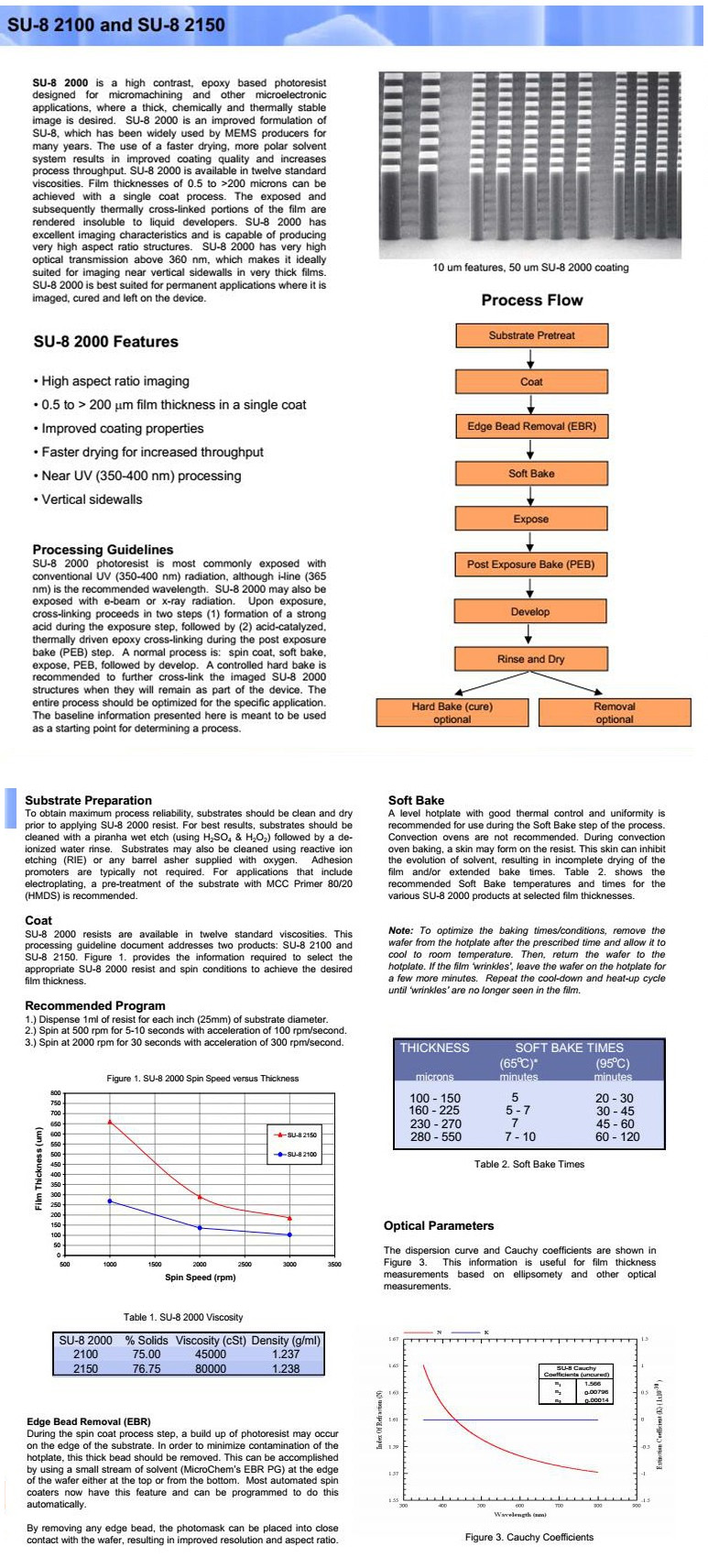Brief introduction of Microchem SU 8 photoresist series
The new chemically amplified negative SU-8 photoresist is a negative, epoxy, near-ultraviolet photoresist, which overcomes the shortage of depth-to-width ratio caused by UV photoresist. It is very suitable for fabricating high aspect ratio microstructures. SU-8 photoresist has a low light absorption in the near-ultraviolet (365nm-400nm) range, and the exposure of the photoresist layer is uniform. The thick film with vertical sidewall and high aspect ratio can be obtained. It also has good mechanical properties, chemical corrosion resistance, and thermal stability. SU-8 crosslinked by UV radiation is a chemically amplified negative adhesive, forming steps and other complex structures. SU-8 adhesive is non-conductive and can be used directly as an insulator in electroplating. Due to its many advantages, SU-8 is gradually being used in MEMS, chip packaging, and micro-machining. At present, the direct use of SU-8 photoresists to prepare high aspect ratio microstructures and micro-parts has become a new technology in micro-machining.
Cleaning process of Microchem SU 8 photoresist before photolithography
For getting a better photolithography effect, the substrate needs to be cleaned before the photoresist coating. The commonly used cleaning method uses concentrated sulfuric acid and hydrogen peroxide mixed solution immersion, followed by cleaning with deionized water and blowing dry with nitrogen. In addition, it can be cleaned by Reactive-ion etching or plasma surface cleaner.
Microchem SU 8 photoresist lithography process
The SU-8 photoresist component is spin-coated on the substrate with a thickness of several to several hundred microns. The coated wafers are dried before being cooled to room temperature. In the drying process, the preferential selection of uniform heating and precise temperature control of the heating plate; can not use the air blast drying box to prevent the photoresist surface priority curing to prevent the evaporation of the inner photoresist solvent. After cooling, the negative mask is exposed to the coated wafer, and the UV radiation dose at the mercury lamp is 10-250 MJ/cm? Under the right conditions. After exposure, choose the appropriate baking temperature and time. The wafer is developed by immersion in the developer and then blown dry with nitrogen.
Advantages of SU-8 photoresist
- The SU-8 photoresist has a low light absorption in the near-ultraviolet (365nm-400nm) region, and the exposure of the photoresist layer is uniform. The thick film pattern with vertical sidewall and high aspect ratio can be obtained
- SU-8 photoresist has good mechanical properties, chemical corrosion resistance, and thermal stability
- SU-8 was crosslinked after being exposed to UV radiation. It is a chemically amplified negative gel, which can form a complex structure such as step
4, SU-8 glue does not conduct electricity when electroplating can be used directly as an insulator.
Due to its many advantages, SU-8 is gradually being used in MEMS, chip packaging, and micro-machining fields. At present, the direct use of SU8 photoresist to prepare high aspect ratio microstructures and micro-parts has become a new technology in micro-machining. In microfluidic chip processing, SU-8 has mainly used for rapid molding of PDMS microfluidic chips.
Type and parameters of photoresist
| Name of photoresist | Type | Spin thickness | Spec |
| MicroChem SU-8 Negative glue | SU-8 2000.5 | 0.5-0.8μm | 100ml;500ml;1L;1加仑 |
| MicroChem SU-8 Negative glue | SU-8 2002 | 2-2.9μm | 100ml;250ml;500ml;1L |
| MicroChem SU-8 Negative glue | SU-8 2005 | 5-8μm | 100ml;250ml;500ml;1L |
| MicroChem SU-8 Negative glue | SU-8 2007 | 7-13μm | 100ml;250ml;500ml;1L |
| MicroChem SU-8 Negative glue | SU-8 2010 | 10-20μm | 100ml;250ml;500ml;1L |
| MicroChem SU-8 Negative glue | SU-8 2015 | 13-38μm | 100ml;250ml;500ml;1L |
| MicroChem SU-8 Negative glue | SU-8 2025 | 20-80μm | 100ml;250ml;500ml;1L |
| MicroChem SU-8 Negative glue | SU-8 2035 | 35-120μm | 100ml;250ml;500ml;1L |
| MicroChem SU-8 Negative glue | SU-8 2050 | 40-170μm | 100ml;250ml;500ml;1L |
| MicroChem SU-8 Negative glue | SU-8 2075 | 60-240μm | 100ml;250ml;500ml;1L |
| MicroChem SU-8 Negative glue | SU-8 2100 | 100-260μm | 100ml;250ml;500ml;1L |
| MicroChem SU-8 Negative glue | SU-8 2150 | 190-650μm | 100ml;250ml;500ml;1L |
| MicroChem SU-8 Negative glue | SU-8 3005 | 5-10μm | 100ml;250ml;500ml;1L |
| MicroChem SU-8 Negative glue | SU-8 3010 | 8-15μm | 100ml;250ml;500ml;1L |
| MicroChem SU-8 Negative glue | SU-8 3025 | 22-60μm | 100ml;250ml;500ml;1L |
| MicroChem SU-8 Negative glue | SU-8 3035 | 32-80μm | 100ml;250ml;500ml;1L |
| MicroChem SU-8 Negative glue | SU-8 3050 | 44-100μm | 100ml;250ml;500ml;1L |
| Merck AZ Positive/negative interchangeable photoresist | AZ 5214 | 0.5-6μm | 100ml;500ml;1L;1Gallons |
| AZ 50XT Positive glue | AZ 50XT | 40-80μm | 100ml;500ml;1Quart |
| AZ 9260 Positive glue | AZ 9260 | 6.2-15μm | 100ml;250ml;500ml;1L;1Gallons |
| AZ2020Positive glue | AZ nl0F2020 | >4μm | 1Gallons |
| AZ1500 Positive glue | AZ 1500(4.4cp/20cp/38cp) | None | 1Gallons |
| AZ9620/AZ4330Positive glue | AZ 9620/AZ 4330 | None | 1Gallons |
| MerckAZ1518Positive glue | AZ 1518 | 1-4.3μm | 1Gallons |
| AZ 4620 Positive glue | AZ 4620 | 10-15μm | 100ml;500ml;1L; |


